Robyn O’Neil, Occurrence, 2009 Graphite on paper 6.5 x 10 inches
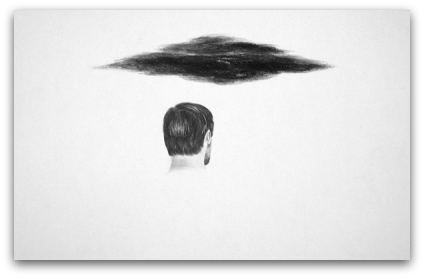 John Grade, Seep of Winter, 2008
John Grade, Seep of Winter, 2008
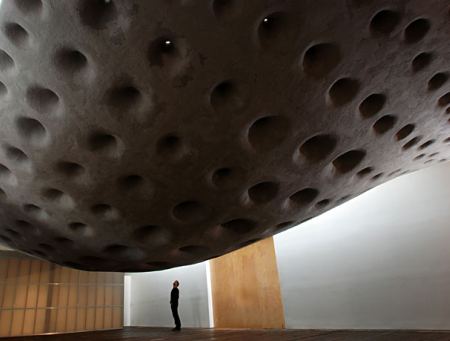
Regina Hackett takes her Art to Go
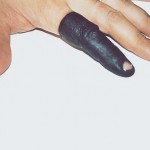
That old grade-school test question - Which of these does not belong? - offers a key to the aesthetics of the expressively hot, as opposed to the classically cool. The hint of crazy within the solid citizen, the blood in the water and the worm in the rose (mortal, guilty) move us in a way that visions of perfection rarely do. In honor of the flaw, a small survey of its recent, robust manifestations. Douglas Gordon Three Inches (Black) 1997 (image via) Susan Robb: Three from the last … [Read More...]
Filed Under: Uncategorized
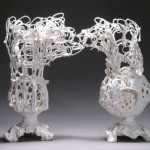
If human history were underwater, Alwyn O'Brien's ceramic vessels could serve as the bleached bones of the Ancien Regime, the decorative drained and dead on a dark sea floor. 4 Descending Notes 2010 Manganese Clay and Glaze 9" x 7" x 5 1/2" Hand-rolled coils make her lacy vessels. Born past their prime, they are in their own weird way pristine. Story of Looking, 2010 Porcelain and glaze, Two Pieces 12 1/2" x 14" x 5" Following Thelonious Monk, she knows how to use the wrong … [Read More...]
Filed Under: Uncategorized
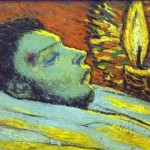
Collectors who hire experts to solve problems that don't exist till help arrives are responsible for the equivalent of bad face lifts on old masters. What the artists intended too frequently recedes under an abrasive cleaning or a deadening layer of varnish. Current practices discourage irreversible interventions. That means John Currin's work is a little safer than artists who preceded him, such as Picasso, although having the money to buy good advice doesn't guarantee it will be heeded. … [Read More...]
Filed Under: Uncategorized
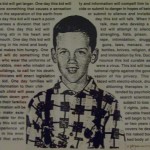
Nice to see David Wojnarowicz (wana-row-vitch) back in the news, making the monkeys dance. It's no surprise that the usual people want to use their deliberate misunderstanding of his work to rally their frightened base. It's also no surprise that the Smithsonian once again proves to be cowardly. Remember its Enola Gay exhibit from 1995? The examination of this country's use of the Atom Bomb started as scholarly and turned into a my-country-right-or-wrong cheering section, after suitable … [Read More...]
Filed Under: Uncategorized
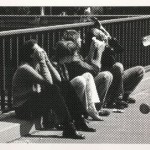
Humans see, humans do: After the first horse drawn on the first cave and the first pot incised with a decorative line, everything became imitation. You don't need a weatherman to know which way that wind blows, or that in the contemporary period, it blows harder. In selecting the 12 artists featured in Image Transfer: Pictures in a Remix Culture, associate Henry curator Sara Krajewski looked for those whose engagements with image recycling make them visual mix masters of note, those who … [Read More...]
Filed Under: Uncategorized
By Regina Hackett Leave a Comment
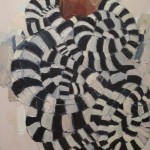
Mequitta Ahuja Wriggle, oil on canvas, 41"X26" 2008. Could have been titled, Medusa takes a nap. Geoffrey Chadsey Welterweight, 2002 Watercolor pencil on rag vellum, tape 57" x 24" Another great Chadsey figure with flowing locks. (Not safe for work.) Lauren Grossman Behold 2003 Iron, wool, steel. 13"x21"x12" Rolls on casters. Mequitta Ahuja, again. Flowback, oil on canvas, 68"X51" 2008 … [Read More...]
Filed Under: Uncategorized
Narratives encased in convention become fluid in The Old, Weird America: Folk Themes in Contemporary Art, inviting the audience to appreciate what Laura Lark called in her excellent review the “complexity of the iconic.”
Organized by Toby Kamps, senior curator
at the Contemporary Arts Museum Houston, the exhibit opened there
in May, 2008, and debuted at the Frye Museum on Saturday. It features 18 young to mid-career artists interested in the roots of an American experience that extends from the Pilgrims to the Space Race.
Eric Beltz, Fuck You Tree, (detail), 2007, graphite on board, 40 x 30 inches
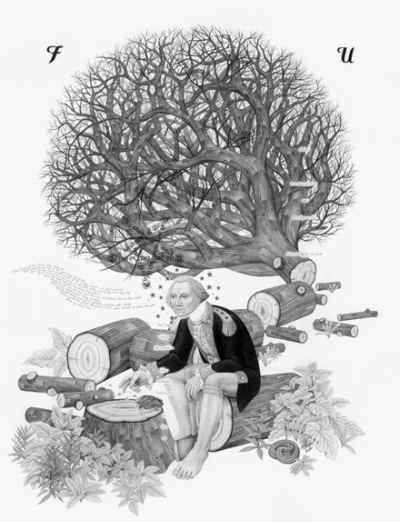 Beltz gave the father of our country lovely feet. If he could stand, they could carry him out of this scene of morbid self-reflection. Instead, he sits on a log from his cherry tree with stars from the original 13 colonies ringing his face like mosquitoes, and his head detached from his body as if ready to be reproduced on dollar bills. The tree itself flourishes behind him as a rootless cosmopolitan, an entangling alliance.
Beltz gave the father of our country lovely feet. If he could stand, they could carry him out of this scene of morbid self-reflection. Instead, he sits on a log from his cherry tree with stars from the original 13 colonies ringing his face like mosquitoes, and his head detached from his body as if ready to be reproduced on dollar bills. The tree itself flourishes behind him as a rootless cosmopolitan, an entangling alliance.
The title of the show comes from the peerless Greil Marcus, who used it for his essay on Bob Dylan’s Basement Tapes, in which Dylan paid homage to American blues and country folk.
Barnaby Furnas’ paintings are a giant step up from Ralph Steadman’s illustrations, which could be a source. Where Steadman relies on endlessly repeated flat splatter, Furnas opens the splatter with electric Kool-Aid colors, scale shifts and the narrative detachment of video games.
When James Baldwin was asked in the late 1950s if there were a candidate he could support for President, he answered, “Yes. John Brown”. The guns firing at Brown’s feet are candles and also flowers reminiscent of Anslem Kiefer’s.
Furnas, John Brown, 2005, Urethane/dye on linen, 72 x 60 inches.
[Read more…] about Godforsaken curios – The Old, Weird America
Seattle is the last stop for The Old, Weird America: Folk Themes in American Art, and Seattle is lucky to get it. As
art museums hunker down with long runs for exhibits featuring objects from their
collections, fewer shows travel. If the recession is over,
nobody told the art world.
The Old, Weird America would be welcome at any time. Organized by Toby Kamps, senior curator at the Contemporary Arts Museum Houston, the exhibit opened in Houston in May, 2008, and debuted at the Frye Art Museum on Saturday, just in time for Thanksgiving.
A review will follow but given the season, I’d like to consider separately Sam Durant‘s Pilgrims and Indians, Planting and Reaping, Learning and Teaching. Its revolving-stage, dual dioramas invite the audience to contemplate who is weirder: those who insist on a fictionalized version of American history or those who dispute it.
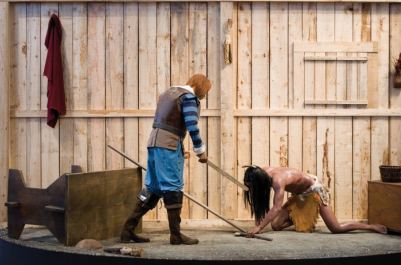
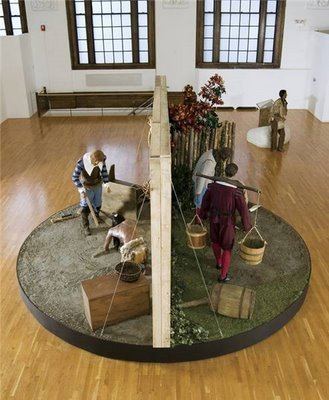 Durant purchased the dioramas from the defunct Plymouth National Wax Museum in Massachusetts. Initially, the museum displayed the accurate version of Thanksgiving’s origins: After Pequot Indian Pecksuot insulted Captain Myles Standish, Standish flew into a rage and killed him. Fearing retribution from Pecksuot’s tribe, Standish organized a raiding party and wiped out the Indians camped nearby. Afterward, settlers celebrated their win by declaring a national day of thanksgiving.
Durant purchased the dioramas from the defunct Plymouth National Wax Museum in Massachusetts. Initially, the museum displayed the accurate version of Thanksgiving’s origins: After Pequot Indian Pecksuot insulted Captain Myles Standish, Standish flew into a rage and killed him. Fearing retribution from Pecksuot’s tribe, Standish organized a raiding party and wiped out the Indians camped nearby. Afterward, settlers celebrated their win by declaring a national day of thanksgiving.
Over the years, the story transformed into its opposite: Pilgrims breaking not bones but bread with the land’s original occupants.
The factual diorama was removed after visitor complaints in the 1970s, leaving the story we know so well.
Reviewing the show for the Boston Globe, its art critic Sebastian Smee trotted out the usual insults for anyone questioning a master narrative from America the beautiful. Smee bemoaned the inclusion of:
familiar forms of patronizing “identity art” – art that addresses, in
the most dutiful, box-ticking ways, the familiar tropes of exclusion
and wrongdoing.
(Two familiars in one sentence? Maybe the Globe no longer deserves its reputation for great editors. I also note with dismay Smee’s lead, which for no good reason is in the passive voice. Had he wanted to leave a snail’s trail of inertia across his copy, passive would serve him. If not, not. )
Back to Smee:
I’m thinking, for instance, of Sam Durant’s two life-size dioramas that
suggest alternative interpretations of the first Thanksgiving. The
dioramas are set up on a circular platform, divided in half, that
slowly revolves. One side shows a Native American teaching a pilgrim
how to grow corn (with the help of a buried herring); the other shows
Captain Myles Standish beating to death the Pequot Indian Pecksuot,
which, the catalog tells us, led to a raid on the Pequots and
subsequent celebration.
Durant purchased both displays from the defunct Plymouth National Wax
Museum in Massachusetts. But to what end? The work he has made from
them is as didactic and kitsch as the originals, and it isn’t saved
from being so by the artist’s ironic know-ingness.
American exceptionalism means Americans never have to say they’re sorry.
Smee fell into the trap of reviewing the subject matter, not the art. I don’t mean to imply the trap is easy to avoid. Personally, I’m relieved to see accuracy creeping into American history by way of art or any other way, if only because too many American myths are found there and fuel attitudes that impede progressive change.
In reacting to Durant, I have to consider whether I am Smee’s twin, responding to what art says rather than what it is. And yet I think it is what it needs to be, an appropriation of frozen moments he sets in motion, fact and fantasy as each other’s form and each other’s shadow.
Flash mobs continue, via
Walking into a warehouse in Portland in 2003, I saw 10 old refrigerators lined up against a wall in an assortment of once tony shades: avocado, orange, dark brown. I opened one and saw a video of a wolf chasing what it hoped would be dinner. Each refrigerator contained a similar chase, but only in one did the wolf score. The title of the piece, Hunting Requires Optimism, struck me as the perfect metaphor for making art.
Vanessa Renwick, creator of Hunting Requires Optimism, is good with titles. (She calls her Web site the Oregon Department of Kick Ass.)
October 7 -9, she hosts a survey of Portland short films at the Northwest Film Forum, titled, A Natural Selection. Missing it is a bad idea.
Still from Melody Owen’s Kayavak
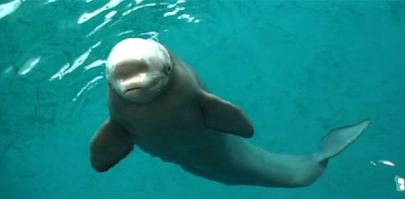 Rewick describes her survey as
Rewick describes her survey as
…some hopping films from Portland’s finest artists. Lions! Bicycles! Melting Polar opposites! Rabbits! Record Stores! Beluga Whales! Tears! Mind bending! and MORE!
They include:
That’s Fine, You’re Doing Perfectly by Karl Lind
Performance by Robin Moore
Lion Roars by Melody Owen
Moonbabies, part 1 of You Were a Perfect Gentleman and part 2 New World by Zak Margolis
Pain Is Fear Leaving Your Body by Alicia McDaid
Storm Studies 1 by Liz Haley
Kayavak by Melody Owen
Portrait #3: House of Sound by Vanessa Renwick
A Vertiginous One by Zach Margolis
Psychic City by Judah Switzer
Straight out of Texas, Rainey Knudsen, founder and director of Glasstire, was the star of the first ever National Summit on Arts Journalism, held in L.A. on Friday. More on Glasstire to follow, but first, a few words about Douglas McLennan, who conceived it and produced it with Sasha Anawalt.
McLennan is best known as founder and editor of ArtsJournal. If you’re reading this, you’re on an AJ site. ArtsJournal is an aggregate of arts news in English around the world, with the additional of a streaming rail of posts from AJ arts bloggers, including me.
More alliances: I live-blogged the summit, here, at Doug’s request. Throw in my friendship with him and clearly I have a dog in this, which influences but does not account for my belief that the summit went well.
Given the free fall of traditional arts journalism, this summit is the first to consider options for replacing it.
Tyler Green (AJ blogger) and Paddy Johnson (nonAJ blogger) were disappointed in advance. Both objected to the idea that a nonprofit can be a business. They say opening the competition to nonprofits was changing the rules.
Although I hesitate to dispute a business question with two people whose entrepreneurial savvy overwhelms my own, I side with the summit on this one. It never said nonprofits couldn’t apply or weren’t businesses.
Nor did it change the rules by “adding” five project models.
After an open call for entries, jurors selected five models to present at the conference. From these, NAJP members voted to select three top entries, all of whom will get cash awards, starting at $9,000. (Winners not yet announced.)
In addition, the Summit asked representatives from five businesses working in support of arts and/or arts journalism to present. They were not part of the contest, were not chosen by jurors and are not eligible for awards. In saying the summit added five projects after the fact, Johnson and Green are factually wrong.
Johnson also wrote that she didn’t watch the summit, which was live-streamed around the world and is still available. Disclosure is good, but why didn’t she watch, especially as she intended to write about it? Even though she was traveling when it took place, she could have caught it later.
On the other hand, I can’t help but admire the vigorous way she attacked McLennan’s baby. He was on the Warhol grants panel this year and successfully argued for her to get one. If speaking her version of truth to power means biting the hand that feeds her, she chomps down.
Back to Glasstire, which Johnson praised as a good model. (Note to Johnson: it’s a nonprofit.) It covers Texas, which is a way of covering the world, as a lot of art flows through the Lone Star State. In nearly a decade of existence online, Glasstire has attracted terrific writers and given them a platform to be regional without being narrow.
I also like that it’s not a design wonder. It serves those who want to think about art, not just click through razzle-dazzle. Its existence is a fundamental challenge to those who maintain that New York and L.A. are where the U.S. art action is, and artists/critics living elsewhere are delusional.
Because time is a way of keeping events from happening all at once, it tends to bury the past. Anyone who wants to see it again has to dig. In Seattle, artREsource offers that opportunity. It’s a regional resale gallery, providing a secondary market for collectors and a chance for the larger audience to see what is no longer current, such as Gene Gentry McMahon’s untitled mural from
1983-84, oil on canvas
24 x 168.75 inches, via
 Detail:
Detail:
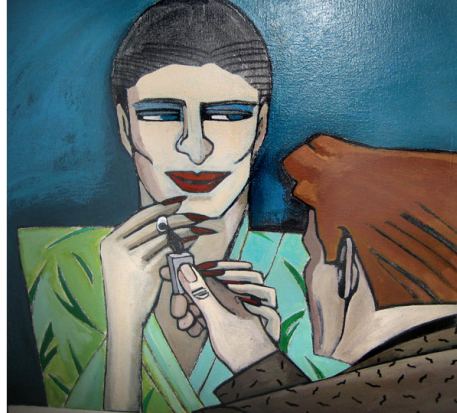
McMahon paints in a comedy-of-manners vein. Back before anyone thought William Hogarth had anywhere to go other than the slag heap of history, she was Hogarth in stilettos, painting
women on the make flirting with underworld thugs.
After that, she developed the most famous case of artist block in the region, down but not out, fighting through two bouts of breast cancer (hers and her daughter’s), holding down a day job as party props creator and struggling to keep her studio practice alive.
Last year, she bounced back with a terrific show at the Grover/Thurston Gallery.
Her self-portrait in that exhibit, Pinkie, 20 x 22 inches, 2008, suggests a new level of self-sufficiency. This figure needs a man like fish needs a bicycle.
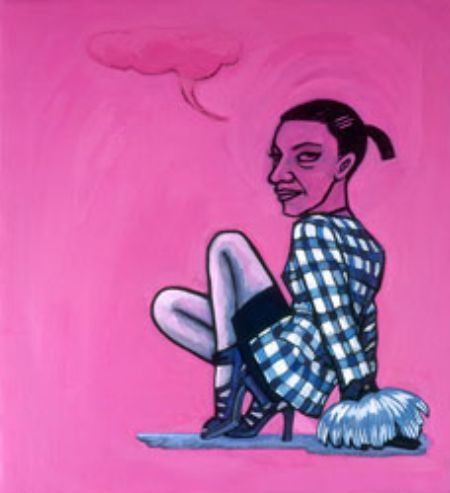
Anthony Discenza, the consolation of art:

an ArtsJournal blog


